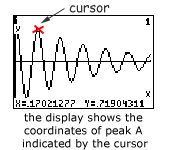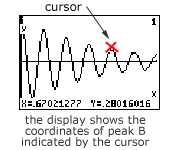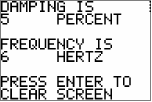5. Calculate Natural Frequency and Damping
|
Use the program FREQDAMP on your TI Graphing Calculator to calculate the natural frequency and damping of your model. You will need to read values from the graphs you saved from the Free-Vibration Decay experiment. |
||||||||||||||||||||||||||||||
5.1 Recall GraphsOn your TI Graphing Calculator recall your clearest graph.
|
||||||||||||||||||||||||||||||
5.2 Select Two PeaksChoose two pairs of (x,y) coordinates from your graph which occur at different peaks, like the ones shown in the graphs. You can choose two positive peaks or two negative troughs. |
||||||||||||||||||||||||||||||
  These are artificially produced graphs to demonstrate how to use the program FREQDAMP. |
||||||||||||||||||||||||||||||
|
Use the cursor
and move it onto the first peak. Write down the (x,y) coordinates for the peaks that you choose AND the number of complete cycles of oscillation between them. |
||||||||||||||||||||||||||||||
Example:Call the point with the lowest x-coordinate peak A and the other point peak B.
Remember, the x-coordinates are time and the y coordinates are acceleration. From the graph above |
||||||||||||||||||||||||||||||
|
Peak A: |
Peak B: |
|||||||||||||||||||||||||||||
|
Number of cycles between two peaks=3 |
||||||||||||||||||||||||||||||
5.3 The CalculationOn your TI Graphing Calculator,
The program will start. Follow the instructions on the calculator display. You can exit the program at any time by pressing ON and then pressing the number before Quit (2 on the TI-82, 1 on the TI-83). You will need to enter the time and acceleration
for both peaks and also the number of cycles between them. If you
have chosen troughs and have negative values for acceleration you
should enter them using the Try out the program using the values from the example graph. The program will calculate the natural frequency and damping and display:
|
||||||||||||||||||||||||||||||
|
You can now use the Accurate Earthquake Mass Calculator to find out the mass you need to load each floor of your model. |
||||||||||||||||||||||||||||||
|
|
|||||||||||||||||||||||||||||

